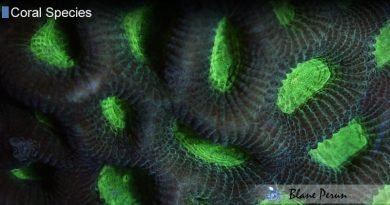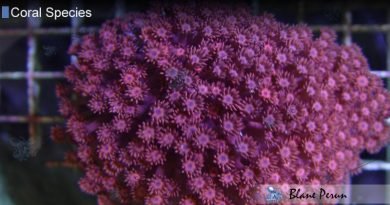Torch Coral
Table of Contents
The scientific name of Torch Coral is Euphyllia glabrescens. It is also commonly known as Grape Coral, Trumpet Coral, Whisker Coral, Branching Anchor Coral or Pom-Pom Coral. Torch Coral is classified as a Large Polyp Stony (LPS) Coral. Its natural habitat originates from the Indo-Pacific region including Figi, Tonga, Solomon Islands and the Great Barrier Reef.
Torch coral occurs in pink, brown, green, golden, yellow and tan colors. It is aggressive towards other marine aquarium invertebrates. Torch coral has a branched skeletal base which is covered by polyps. It has sweeper tentacles tipped by the stinging cells, or nematocysts. The polyps of this coral are long and have a single rounded tip.
Torch Coral requires moderate to high intensity indirect lighting. Actinic lighting and/or high output fluorescent lighting such as VHO and Power Compact are recommended. The coloration of the Torch Coral may be determined by the intensity of the light that the coral is exposed to. This type of coral may take some time to adjust to Metal Halide lighting.
Torch Coral needs indirect, moderate water current in the marine environment in which it inhabits. Exposing Euphyllia glabrescens to direct, strong water current may hamper its ability to spread. If the polyps of this coral in your aquarium do not open up fully, you need to check the water quality in your aquarium. Water must be kept clean and free of all infectious organisms.
Euphyllia glabrescens derives its nutrition mainly through photosynthesis, performed by zooxanthellae, a photosynthetic algae living symbiotically with the coral. Torch coral also feeds upon acellular marine invertebrates, frozen meaty bits of raw shrimp, Silver Side, fish, squid, zooplankton and phytoplankton. Adding calcium, strontium and trace elements to the water of the aquarium is also beneficial.
Torch coral has long sweeper tentacles that can sting other marine invertabrate in the aquarium that touches them. Its a good idea to keep other tank members at a safe distance away to avoid any problems. This type of coral can also sting humans as well, so its advisable to handle the coral carefully to avoid the painful burning sensation and blisters from stings. These stings are painful, but the effects usually only last about 24 hours.
The Enchanting World of Torch Coral: A Deep Dive into Euphyllia glabrescens
Understanding Torch Coral: An Overview
What Makes Torch Coral Unique?
Torch Corals, scientifically known as Euphyllia glabrescens, are among the most captivating species found in marine aquaria. These corals are known for their distinct, long tentacles tipped with a glowing luminescence, resembling a burning torch – hence their name. Torch Corals belong to the family Euphylliidae, a group renowned for their hardy skeletal structure and vivid coloration. These corals are a mixotrophic species, deriving nutrients both from photosynthesis, aided by symbiotic algae called zooxanthellae, and from capturing tiny particles and plankton from the water.
Habitat and Geographic Distribution
Native to the Indo-Pacific region, Torch Corals thrive in shallow, warm waters where sunlight is abundant. They are commonly found at depths ranging from 5 to 35 meters, often anchoring themselves on reef slopes or lagoons. These environments provide the ideal balance of light and water flow, essential for their growth and health. The specific conditions of their habitat, including water temperature, salinity, and pH levels, play a crucial role in their development and coloration.
Torch Coral Care and Maintenance
Aquarium Conditions for Optimal Health
Maintaining Torch Corals in an aquarium requires a careful balance of several factors. Ideal water conditions include a temperature range of 75-82°F (24-28°C), a pH level of 8.1 to 8.4, and specific gravity of 1.023-1.025. These corals also need moderate to strong water flow and lighting to thrive. It’s crucial to provide a stable environment, as fluctuations in these parameters can stress the coral, leading to bleaching or disease.
Feeding and Nutrition
Feeding Torch Corals is an essential aspect of their care. While they benefit significantly from the photosynthetic activities of their zooxanthellae, supplemental feeding ensures optimal health and growth. Targeted feeding with microplankton or finely minced seafood can provide the additional nutrients these corals need. It’s important to feed them in moderation to avoid polluting the tank and causing water quality issues.
Reproduction and Growth of Torch Coral
Sexual and Asexual Reproduction
Torch Corals reproduce both sexually and asexually. Sexual reproduction involves the release of eggs and sperm into the water, leading to external fertilization. Asexually, they can propagate through fragmentation, a process where a piece of the coral breaks off and develops into a new colony. This method is particularly favored by aquarists for coral propagation.
Growth Patterns and Rates
The growth rate of Torch Coral varies depending on environmental conditions. In optimal conditions, they can grow relatively fast, adding several inches to their size annually. Their growth pattern is primarily vertical, with new polyps budding off from the base of the coral. Understanding and maintaining the ideal conditions for their growth is vital for a thriving coral display.
Common Issues and Solutions in Torch Coral Keeping
Dealing with Pests and Diseases
Pests like flatworms and certain types of snails can pose a threat to Torch Corals. Regular inspection and maintaining good water quality can prevent most infestations. In case of pest problems, carefully removing the pests or treating the water with safe chemicals can be effective.
Preventing Coral Bleaching
Coral bleaching is a common issue, often caused by environmental stressors such as poor water quality or excessive light. To prevent bleaching, it’s essential to acclimate the coral gradually to the aquarium conditions and monitor the water parameters closely. Adequate shading and stable temperatures are also crucial for preventing stress and bleaching.
Torch Coral in Aquascaping and Reef Tanks
Role in Reef Tank Ecosystems
Torch Corals play a significant role in reef tank ecosystems. Their unique structure provides shelter and habitat for various marine creatures. Additionally, their vibrant colors and dynamic movement add aesthetic value to the aquarium.
Designing with Torch Coral
When incorporating Torch Coral into aquascaping, consider their need for space and water flow. Placing them in areas where they can sway freely without touching other corals is crucial. Their striking appearance makes them excellent focal points in reef tank designs.
Frequently Asked Questions About Torch Coral
- What is the ideal lighting for Torch Coral in an aquarium? Torch Coral thrives under moderate to strong lighting conditions. LED lights with a full spectrum or T5 fluorescent bulbs are ideal. It’s important to acclimate them gradually to the lighting in your tank to avoid stress or bleaching.
- How often should Torch Coral be fed? While they benefit from the photosynthesis of their symbiotic algae, supplemental feeding 2-3 times a week can promote better health and growth. Use microplankton or finely minced seafood for targeted feeding.
- Can Torch Coral be kept with other coral species? Yes, Torch Corals can coexist with other coral species, but it’s important to provide enough space between them. Their long, sweeping tentacles can sting and damage nearby corals if they come into contact.
- How do you propagate Torch Coral? Torch Coral can be propagated through fragmentation. This involves carefully breaking off a piece of the coral and securing it in a place where it can grow into a new colony. Ensure that both the parent and the new fragment are stable and healthy.
- What are the signs of a healthy Torch Coral? A healthy Torch Coral displays vibrant colors, extended polyps, and a steady growth rate. The coral should also react to stimuli, such as closing its polyps when disturbed. Regular monitoring and maintenance of water parameters are essential for their health.




